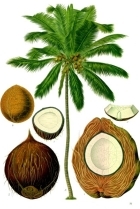Cooking with Coconut Flour

More and more people are discovering the many benefits and uses of coconuts. Aside from extra virgin coconut oil, there are many other great coconut products in the market and one of the must-haves in the galley is organic coconut flour which is also gluten free.
Organic coconut flour is healthy and delicious alternative to traditional flours. It is high in fiber, rich in proteins and contains healthy fats and, being gluten free it's a great alternative for those with gluten intolerance and Celiac Disease. It is also recommended for people with digestive problems such as Leaky Gut Syndrome.
It's also low in sugar with a low score on the glycemic index so it can also be a useful food in the dietary control of diabetes.
For Paleo dieters and vegetarians, coconut flour also adds a bit of variety to the menu.
How is Coconut Flour Made?
Coconut flour is made from dried and ground coconut meat. That’s it! No grains or nuts are added, it's made from 100% pure coconut.
The process is pretty simple. Once the outer green husk of the coconut is removed, the rich, white coconut meat is baked at a low temperature to dry it out and create a powdery flour.

Nutritional Benefits of Coconut Flour:
-
Helps Metabolism - fatty acids in coconut flour are used by the body for energy and to support a healthy metabolism.
-
Fiber Rich - coconut meat has 61% dietary fiber.
-
Not all the calorific value of coconut flour is absorbed.
-
Coconut flour is beleived to help remove toxins from the digestive tract.
-
Good for Diabetics and helps to maintain healthy blood sugar levels which also helps to regulate the appetite.
-
High in both soluble and insoluble dietary fiber to promote healthy digestion.
-
Promotes a healthy heart - coconut flour helps lower bad cholesterol.

Expert Tips for Cooking with Coconut Flour
Organic coconut flour can be used by chefs in both sweet and savoury dishes. It is unsweetened and has a light taste and smell of coconuts which blends well with other ingredients and does not overpower other tastes. Coconut flour has a light, airy appearance and texture, with 5 grams of fibre in a 2 tablespoon serving.
-
It is best to de-clump the flour first before cooking. Mix coconut flour with a fork to take out any air bubbles or lumps
-
Organic coconut flour can be used to thicken soups and stews and in place of breadcrumbs
-
Always remember that coconut flour cannot be substituted for wheat flour at a 1:1 ratio
-
It takes six eggs and one cup of liquid to balance one cup of coconut flour
-
When using coconut flour in place of regular or grain-based flours in recipes, substitute each cup of your grain-based flour for approximately ¼ cup coconut flour. If the batter is too loose, increase the amount of coconut flour to 1/3 cup
-
Coconut flour is very absorbent and can dry out some recipes, so remember to adjust the liquid when substituting coconut flour for other types of flour in your favourite recipes.
About the author:
Nadine Escudero is a wandering writer and blogger. She loves travelling and exploring new places, and finding hole-in-the-wall dining places. As a wannabe cook, she loves discovering new recipes and ingredients, like the versatile coconut oil (and yes, she uses it on just about anything and everything). On lazy days, Nadine is spending time at the beach with her fur-babies, Pepe and Pido.
Sources:
Coconut Flour Nutrition
Coconut Flour Recipes
*Image credit: Franz Eugen Köhler via WikimediaCommons

Post your comment
You cannot post comments until you have logged in.
Login to post a commentComments
No one has commented on this page yet.
RSS feed for comments on this page | RSS feed for all comments